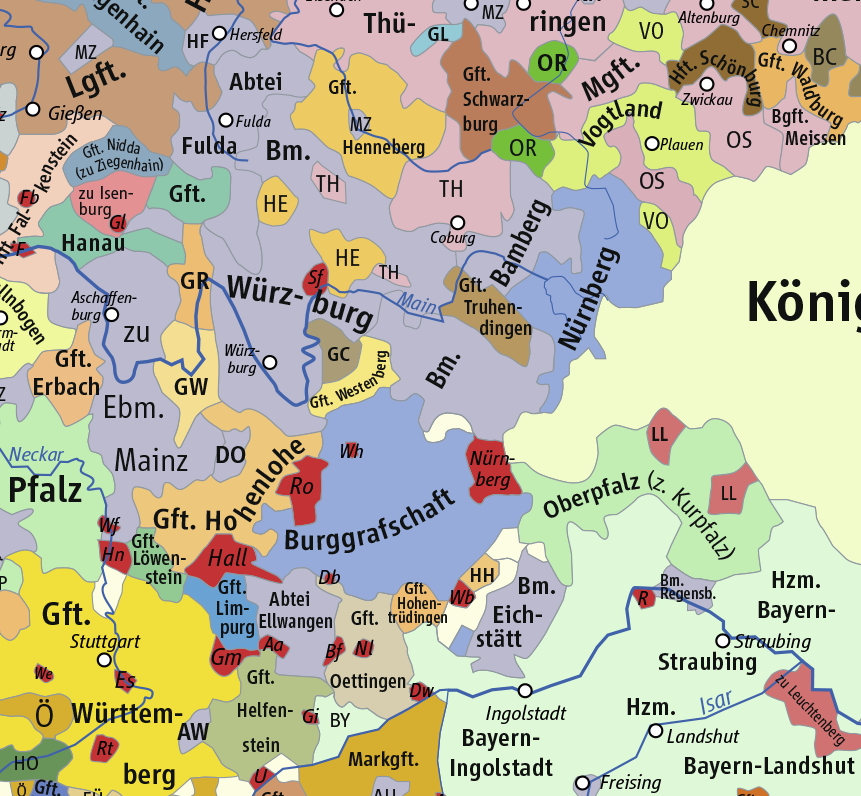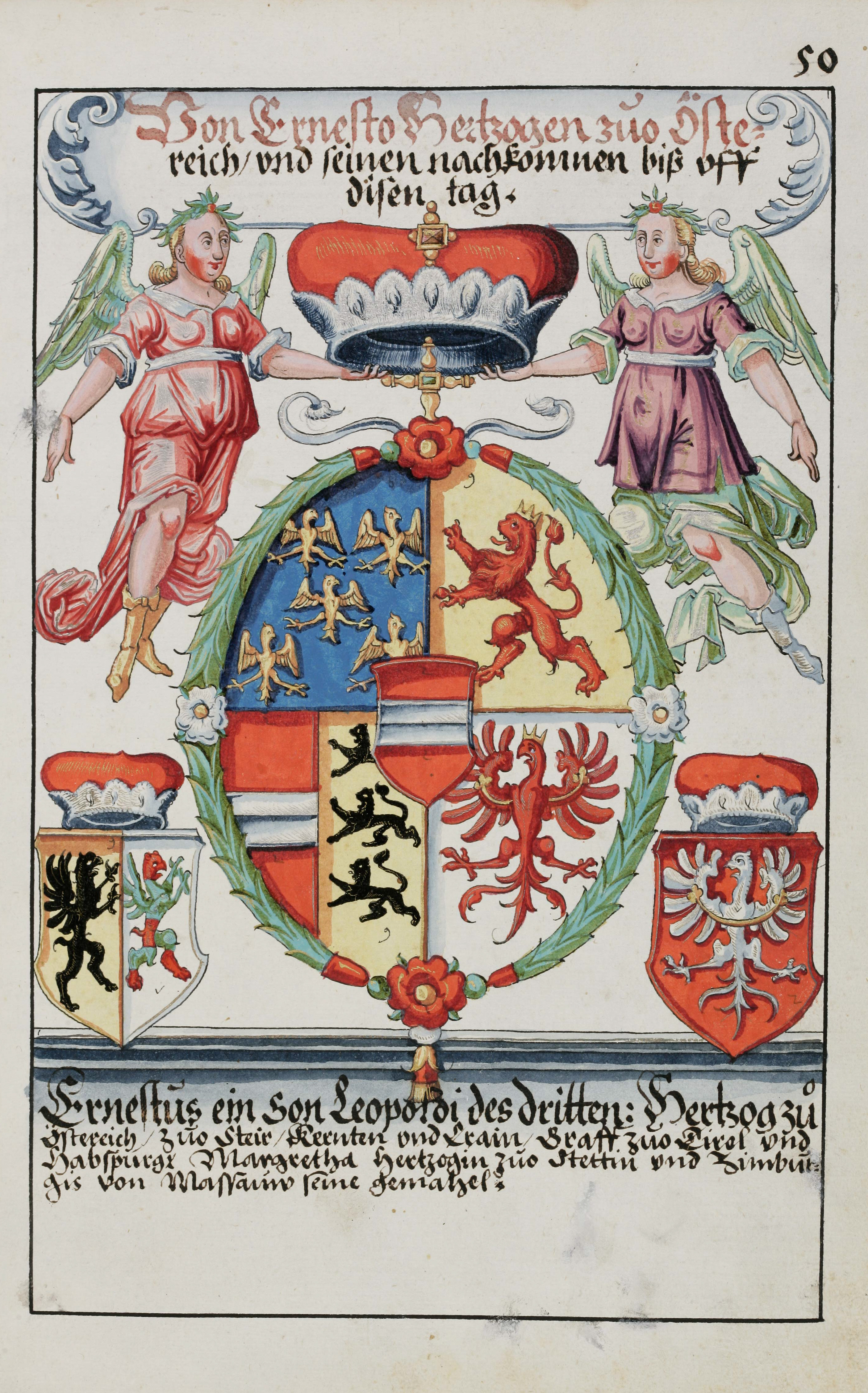|
Siegmund, Margrave Of Bayreuth
Siegmund of Brandenburg-Bayreuth (27 September 1468, in Ansbach – 26 February 1495, in Ansbach) was the sixth, but third surviving, son of Albrecht III, Margrave of Brandenburg, Ansbach and Bayreuth. His mother was his father's second wife, Anna of Saxony. On the death of his father on 11 March 1486, his elder brothers Johann Cicero and Friedrich succeeded to Brandenburg and Ansbach respectively, and Siegmund succeeded to Bayreuth Bayreuth (, ; bar, Bareid) is a town in northern Bavaria, Germany, on the Red Main river in a valley between the Franconian Jura and the Fichtelgebirge Mountains. The town's roots date back to 1194. In the 21st century, it is the capital of U .... He never married, and at his death Bayreuth passed to his elder brother Frederick I of Ansbach. Ancestors External links * Bayreuth, Siegmund Margrave of Bayreuth, Siegmund Margrave of Margraves of Bayreuth Burials at Heilsbronn Abbey {{Germany-margrave-stub ... [...More Info...] [...Related Items...] OR: [Wikipedia] [Google] [Baidu] |
House Of Hohenzollern
The House of Hohenzollern (, also , german: Haus Hohenzollern, , ro, Casa de Hohenzollern) is a German royal (and from 1871 to 1918, imperial) dynasty whose members were variously princes, electors, kings and emperors of Hohenzollern, Brandenburg, Prussia, the German Empire, and Romania. The family came from the area around the town of Hechingen in Swabia during the late 11th century and took their name from Hohenzollern Castle. The first ancestors of the Hohenzollerns were mentioned in 1061. The Hohenzollern family split into two branches, the Catholic Swabian branch and the Protestant Franconian branch,''Genealogisches Handbuch des Adels, Fürstliche Häuser'' XIX. "Haus Hohenzollern". C.A. Starke Verlag, 2011, pp. 30–33. . which ruled the Burgraviate of Nuremberg and later became the Brandenburg-Prussian branch. The Swabian branch ruled the principalities of Hohenzollern-Hechingen and Hohenzollern-Sigmaringen until 1849, and also ruled Romania from 1866 to 1947. ... [...More Info...] [...Related Items...] OR: [Wikipedia] [Google] [Baidu] |
Frederick V, Burgrave Of Nuremberg
Frederick V of Nuremberg (before 3 March 1333 – 21 January 1398) was a Burgrave (''Burggraf'') of Nuremberg, of the House of Hohenzollern. Life He was the elder son of John II, Burgrave of Nuremberg and Elisabeth of Henneberg. From the death of his father in 1357, Frederick bore the title of ''Burgrave'' and so was responsible for the protection of the strategically significant imperial castle of Nuremberg. His zeal in the imperial cause led Charles IV to elevate him in 1363 to be the first Burgrave of royal rank. After his death, his sons divided their inheritance. The eldest son, John III became the first Margrave of Brandenburg-Kulmbach. Johann's brother Frederick VI became the next Burgrave of Nuremberg as well as the first Margrave of Brandenburg-Ansbach. Frederick VI went on to become the first Hohenzollern Elector of Brandenburg. Family and children He married in 1356 Elisabeth of Meissen, daughter of Frederick II, Margrave of Meissen and Matilda of Bavaria. ... [...More Info...] [...Related Items...] OR: [Wikipedia] [Google] [Baidu] |
1495 Deaths
Year 1495 ( MCDXCV) was a common year starting on Thursday (link will display the full calendar) of the Julian calendar. Events January–December * February – King's College, Aberdeen, predecessor of the University of Aberdeen in Scotland, is founded on the petition of William Elphinstone, Bishop of Aberdeen. It is the first English-speaking university to teach medicine. * February 22 – Italian War of 1494–98: King Charles VIII of France enters Naples, to claim the city's throne. A few months later, he decides to return to France, and leaves Naples with most of his army, leaving a force under his cousin Gilbert, Count of Montpensier as viceroy. Syphilis is first definitely recorded in Europe during this invasion. (perhaps from French forces who may have contacted Croats fleeing an Ottoman army in the east). * May 26 – A Spanish army under Gonzalo Fernández de Córdoba lands in Calabria, with the purpose of ousting the French and restoring F ... [...More Info...] [...Related Items...] OR: [Wikipedia] [Google] [Baidu] |
1468 Births
Year 1468 ( MCDLXVIII) was a leap year starting on Friday (link will display the full calendar) of the Julian calendar. Events January–December * June 30 – Catherine Cornaro is married by proxy to James II of Cyprus, beginning the Venetian conquest of Cyprus. * August 26 – Baeda Maryam succeeds his father Zara Yaqob, as Emperor of Ethiopia. * October 14 – The Treaty of Péronne is signed by Charles the Bold, Duke of Burgundy, and Louis XI of France. Date unknown * The Lancastrians surrender Harlech Castle to King Edward IV of England after a seven-year siege. * The Great Council of the Republic of Venice attempts to curb the power of the Council of Ten through legislation restricting them to acting on emergency matters. * Orkney is pledged by Christian I, in his capacity as King of Norway, as security against the payment of the dowry of his daughter Margaret, betrothed to James III of Scotland. As the money is never paid, the connection ... [...More Info...] [...Related Items...] OR: [Wikipedia] [Google] [Baidu] |
Margrave Of Brandenburg-Kulmbach
The Principality of Bayreuth (german: Fürstentum Bayreuth) or Margraviate of Brandenburg-Bayreuth (''Markgraftum Brandenburg-Bayreuth'') was an immediate territory of the Holy Roman Empire, ruled by a Franconian branch of the Hohenzollern dynasty. Since Burgrave Frederick VI of Nuremberg was enfeoffed with the Margraviate of Brandenburg in 1415/17, the Hohenzollern princes transferred the margravial title to their Franconian possessions, though the principality never had been a march. Until 1604 they used Plassenburg Castle in Kulmbach as their residence, hence their territory was officially called the Principality of Kulmbach or Margraviate of Brandenburg-Kulmbach until the Empire's dissolution in 1806. Geography The Kulmbach-Bayreuth principality arose from the northern uplands (''Oberland'') of the former Burgraviate of Nuremberg, while the southern lowlands (''Unterland'') formed the Principality of Ansbach. The final border demarcation was settled by the 1541 House Trea ... [...More Info...] [...Related Items...] OR: [Wikipedia] [Google] [Baidu] |
Albert III Achilles, Elector Of Brandenburg
Albrecht III (9 November 141411 March 1486) was Elector of Brandenburg from 1471 until his death, the third from the House of Hohenzollern. A member of the Order of the Swan, he received the cognomen ''Achilles'' because of his knightly qualities and virtues. He also ruled in the Franconian principalities of Ansbach from 1440 and Kulmbach from 1464 (as Albrecht I). Biography Early life Albrecht was born at the Brandenburg residence of Tangermünde as the third son of the Nuremberg burgrave Frederick I and his wife, the Wittelsbach princess Elisabeth of Bavaria-Landshut. His father served as governor in Brandenburg; a few months after Albrecht's birth, he was enfeoffed with the electorate at the Council of Constance by the Luxembourg emperor Sigismund. After passing some time at the court of Emperor Sigismund, Albrecht took part in the Hussite Wars, and afterwards distinguished himself whilst assisting Sigismund's successor, the Habsburg king Albert II of Germany, against the ... [...More Info...] [...Related Items...] OR: [Wikipedia] [Google] [Baidu] |
Cymburgis Of Masovia
Cymburgis of Masovia (german: Cimburgis von Masowien), ( lt, Cimbarka Mazovietė), also Zimburgis or Cimburga ( pl, Cymbarka mazowiecka; 1394 or 1397 – 28 September 1429), a member of the Polish Piast dynasty, was Duchess of Austria from 1412 until 1424, by her marriage with the Habsburg duke Ernest the Iron. As the mother of later Emperor Frederick III, Cymburgis, after Gertrude of Hohenberg, became the second female ancestor of all later Habsburgs, as only her husband's Ernestine branch of the family survived in the male line. Life She was the second daughter of Duke Siemowit IV, a scion of the Masovian branch of the Piasts, and his consort Alexandra, a daughter of Grand Duke Algirdas of Lithuania from the dynasty of Gediminids and sister of King Władysław II Jagiełło of Poland. Though his elder brother William's engagement with the Polish princess Jadwiga had mortifyingly failed, Duke Ernest the Iron, after the death of his first wife Margaret of Pomerania, proc ... [...More Info...] [...Related Items...] OR: [Wikipedia] [Google] [Baidu] |
Ernest, Duke Of Austria
Ernest the Iron (; 1377 – 10 June 1424), a member of the House of Habsburg, ruled over the Inner Austrian duchies of Styria, Carinthia and Carniola from 1406 until his death. He was head of the Habsburg Leopoldian line from 1411. Biography Ernest was born in Bruck an der Mur in Styria, the third son of Duke Leopold III of Austria (1351–1386) and his consort Viridis Visconti (d. 1414), a daughter of Bernabò Visconti, Lord of Milan. Shortly after his birth, his father and his uncle Albert III divided the Habsburg lands by the 1379 Treaty of Neuberg: while Albert and his Albertinian descendants would rule over the Duchy of Austria proper, the Leopoldian line received the Inner Austrian states of Styria, Carinthia and Carniola with the remaining March of Istria, as well as Tyrol and the Further Austrian possessions. After Leopold's death in the 1386 Battle of Sempach, young Ernest and his brothers William, Leopold IV and Frederick IV remained under the guardians ... [...More Info...] [...Related Items...] OR: [Wikipedia] [Google] [Baidu] |
Catherine Of Brunswick-Lüneburg
Catherine of Brunswick-Lüneburg (1395 – 28 December 1442, Grimma) was a member of the House of Welf, a princess of Brunswick-Lüneburg and by marriage, the Electress of Saxony. Life Catherine was the only daughter and second child of the Duke Henry I of Brunswick-Lüneburg († 1416) from his first marriage to Sophie († June 1400), daughter of Duke Wartislaw VI of Pomerania. As a 7-year-old she married on 7 February 1402 Margrave Frederick IV "the Warlike" of Meissen (1370–1428), who in 1425 became the first Elector of Saxony, as Frederick I. The elector lost a large part of his army in the Hussite Wars in a battle in 1425 at Most. During Frederick's absence, Electress Catherine organized another army of 20,000 men, which rushed to Frederick's aid, but was defeated devastatingly in the Battle of Aussig in 1426. Catherine spent time with her husband, but more frequently alone, at Mildenstein Castle in Leisnig Leisnig ( hsb, Lěsnik) is a small town in t ... [...More Info...] [...Related Items...] OR: [Wikipedia] [Google] [Baidu] |
Frederick I, Elector Of Saxony
Frederick I, the Belligerent or the Warlike (german: Friedrich der Streitbare; 11 April 1370 – 4 January 1428), a member of the House of Wettin, ruled as Margrave of Meissen from 1407 and Elector of Saxony (as Frederick I) from 1423 until his death. He is not to be confused with his cousin Landgrave Frederick IV of Thuringia, the son of Landgrave Balthasar. Biography He was the eldest son of Frederick III, Landgrave of Thuringia, and Catherine of Henneberg. After the death of his uncle William I, Margrave of Meissen in 1407, he was made governor of the Margraviate of Meissen together with his brother William II as well as with his cousin Frederick IV (son of Balthasar), until their possessions were divided in 1410 and 1415. In the German town war of 1388 he assisted Frederick V of Hohenzollern, burgrave of Nuremberg, and in 1391 did the same for the Teutonic Order against Wladislaus II of Poland. He supported Rupert III, Elector Palatine of the Rhine, in his str ... [...More Info...] [...Related Items...] OR: [Wikipedia] [Google] [Baidu] |
Maddalena Visconti
Maddalena Visconti (1366 – 17 July 1404) was a daughter of Bernabò Visconti and his wife Beatrice Regina della Scala. Maddalena was Duchess of Bavaria-Landshut by her marriage to Frederick, Duke of Bavaria. Family Maddalena was born in Milan and was the twelfth of seventeen children born to her parents. Maddalena's maternal grandparents were Mastino II della Scala and his wife Taddea da Carrara. Her paternal grandparents were Stefano Visconti and his wife Valentina Doria. Her father, Bernabò was a cruel and ruthless despot, and an implacable enemy of the Church. He seized the papal city of Bologna, rejected the Pope and his authority, confiscated ecclesiastical property, and forbade any of his subjects to have any dealings with the Curia. He was excommunicated as a heretic in 1363 by Pope Urban V, who preached crusade against him. When Bernabò was in one of his frequent rages, only Beatrice Regina (her mother) was able to approach him. Marriage Maddalena married ... [...More Info...] [...Related Items...] OR: [Wikipedia] [Google] [Baidu] |
Frederick, Duke Of Bavaria-Landshut
Frederick (1339 – 4 December 1393) was Duke of Bavaria from 1375. He was the second son of Stephen II and Elizabeth of Sicily. Family His maternal grandparents were Frederick III of Sicily and Eleanor of Anjou. Her parents were Charles II of Naples and Maria Arpad of Hungary. Maria was a daughter of Stephen V of Hungary and his wife, queen Elisabeth, who was daughter of Zayhan of Kuni, a chief of the Cuman tribe and had been a pagan before her marriage. Stephen V was a son of Béla IV of Hungary and Maria Laskarina. Maria Laskarina was a daughter of Theodore I Lascaris and Anna Angelina. Anna was daughter of Eastern Roman Emperor Alexios III Angelos and Euphrosyne Doukaina Kamatera. Reign From 1375 to 1392 he ruled Bavaria-Landshut jointly with his brothers Stephen III and John II and managed to administer the richest part of the duchy, the region of Landshut which he also kept after the division of Bavaria among the brothers in 1392, when Bavaria-Landshut was re ... [...More Info...] [...Related Items...] OR: [Wikipedia] [Google] [Baidu] |






